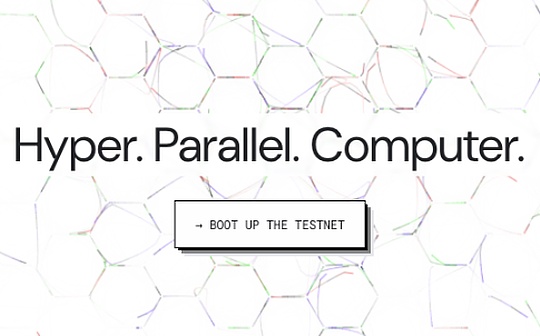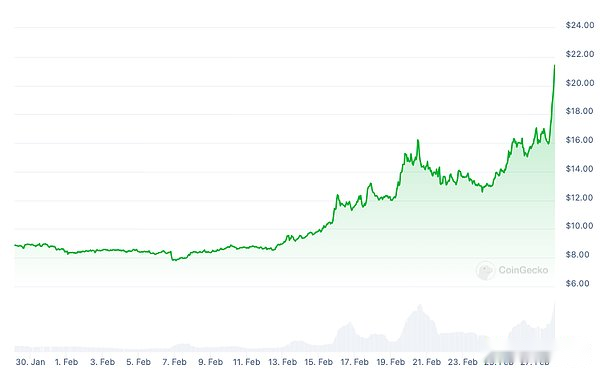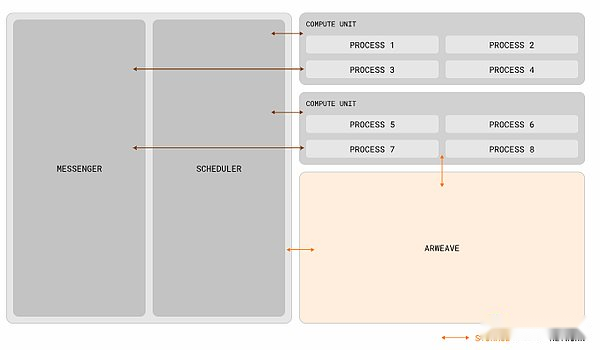
Written article: 0xjs@:
Two weeks after the launch of the preview of the ultra -parallel computer AO, in the early morning of February 28, 2024, Beijing time, the decentralized storage project Arweave officially released the AO open test network.
From the preview to the official launch, the price of the ARWEAVE tokens has risen more than doubled.

According to the Arweave team, Arweave had this idea as early as 2020, that is, Arweave data storage platform can support highly scalable blockchain networks.In 2023, when the plan to use token representative content ownership, it was aware that a highly scalable network was required to support such token markets, and then began to develop silently.
Arweave founder Wiliams said that AO built an ultra -line computer, which can run any computers with any number of threads in parallel, which is incredible.
In other words, Arweave, which originally made decentralized storage, entered the computing and smart contract market.Although the architecture and methods it adopt are very different in public chain such as Ethereum, in fact, they have entered the public chain market and competed with them.
Arweave founder Williams said AO has confidence to compete with Ethereum.So what exactly is AO?What kind of characteristics make its founder confidence to compete with Ethereum?
What is AO?
According to AO official documents, AO computers are the Actor Oriented machines that emerge from the node network complied with its core data protocol and run on the Arweave network.Here are a brief introduction to the protocol and its functions and technical details.
AO computer is a single, unified computing environmentIt is a system), a set of heterogeneous nodes in a distributed network.AO aims to provide an environment, which can be in parallel processes that can be reserved at arbitrary number and coordinate through an open message transfer layer.This message transmission standard connects the independent operation process of the machine into a “network”, just like the website runs on an independent server but is connected to a unified unified experience through the hyperlink.
Unlike the existing decentralized computing system, AO can support the computing operation without the need to protocol the size and form, and at the same time maintain the verification of the network itself (so as to minimize trust).In addition, AO distributed and modular architecture allows existing smart contract platforms to easily “insert” the network to act as a single process that can send and receive messages from any other process.
AO is not forced to perform a set of options for all users of the computing environment, but is built in the form of modularity.AO allows users to choose the virtual machine, decentralized sorting weighing, message security guarantee and payment options that are most suitable for them.Then, the modular environment is finally settled to the decentralized data layer of arweave by the same message (the same format each message shared each message).This modularization creates a unified calculation environment suitable for extremely wide working loads, which can easily transmit messages and collaborate in each process.
AO’s core goal is to achieve computing services without trust and collaboration without any actual scale limit.This provides a new design space for the application, which integrates the advantages of smart contract applications (the services that do not trust anything except code) and the advantages of traditional computing environments (Amazon EC2, etc.).
Due to its scalability, the natural method of developers using AO is to generate their own command lines (AOS) processes in the network and start ordering.This developer experiences similar to developers to create a new server instance on the host and connect to it through SSH, but this command line process has the attributes of smart contracts.Their order process AO does not exist in any specific data center or any physical location, and its calculations are completely unscrupulous.Each user can send messages and interact with all other processes and programs.As a result, a global “single system image”: a unified computer -distributed in all parts of the world, running at any size -sharing between all users.
From the perspective of end users or developers,AO is essentially simple: AO is a shared computer that can run any process in which the process is running.These processes are not controlled on any specific server and are not controlled by any individual or group.On the contrary, once the start of these processes, these processes can be commissioned by encrypted methods to prove the service in a neutral way.This enables them to guarantee the right of users over time.
AO core function
Compared with the existing decentralization and distributed computing system, the AO protocol has the following characteristics:
The process of running any number (“contract”): In AO, the application is constructed by the communication process of any number.Inspired by the original Actor model (Carl Hewitt (1973) and Erlang, AO does not allow sharing memory between processes, but allows them to coordinate through native message transfer standards.Then, each of these processes can run at full speed of computing resources without interfering with each other.By focusing on message transmission, AO can realize an extension mechanism that is more similar to the traditional web2/distributed system environment than traditional smart contracts.
Utilization of unlimited resources in the process:Based on the delayed evaluation architecture based on the original version of Smartweave and Lazyledger (later renamed Celestia), nodes in the AO network can reach a consensus transition from the program status without performing any calculations.The state of the process is “holographic” hosted by Arweave.Then, the calculation cost is entrusted to the user, they can calculate their own status, or request the nodes they choose to execute.
Visit the native unlimited hard disk Arweave: The AO process can seamlessly load any size data directly to the memory, execute and write back to the network.This setting has eliminated typical resource restrictions and achieved complete parallel execution, which has greatly expanded the possibility of application development and surpassed the restrictions of traditional smart contract platforms.Therefore, it opens the door for complex applications that require a large amount of data processing and computing resources, such as machine learning tasks and high -computing autonomous intelligence.
Automatic activation contract:In the traditional smart contract environment (such as Ethereum, Solana, Polygon, etc.), the contract will be calculated according to the request of user transaction.This creates an environment. In this environment, unless the user interacts with the program, the program is not “real -time”, which reduces the range of applications that can be constructed on it.AO eliminates this limit by allowing the “CRON” interaction to allow the contract to be allowed to eliminate this limit. These interactions will automatically awaken them and perform calculations at the set time interval.Any user, or actually the process itself, can pay from the node to the “subscription” process in order to trigger the calculation assessment at the appropriate frequency.
Support the expansion modular structure:The core architecture of AO is an open data protocol, and anyone can build it.Everything -from sorter, message relay, and even system virtual machine -can be exchanged and expanded at will.This flexibility will allow the existing smart contract systems (Warp, Ever, MEM, etc.) in the Arweave ecosystem to insert AO unified network and can send and receive messages from a unified network.This will also allow all these smart contract systems to share some of the same infrastructure and tools, thereby providing a more coherent computing experience on Arweave.
AO basic architecture
process(Processes)),:,Calculation unit of the network.The process is stored inArweaveThe interactive message log and initialization data item representation.The process defines the computing environment (its virtual machine, scheduling program, memory demand and necessary extension) when initialization.Although the process is expressed in the consensus level in this way, they also mean that they can be calculated by the calculation unit that meets the requirements and selects the state of the process.In addition to receiving messages from the user wallet, the process also forwarded the message from other processes through the message unit.Process developers can freely choose how to determine the credibility of these messages.
information(Messages)),:,Each interaction with the process is represented by the message.The core of the message is the ANS-104 standard data item.Users and processes (through their hairboxes and message units) can send the message to other processes on the network through the scheduling program.The semantics of AO message is between UDP and TCP packets: It is guaranteed to be passed only once, but if the message has never been forwarded by the message unit -or the receiver has never actually handled it -then its transmission will not occur.
Scheduling program unit (Scheduler units,SU):Responsible for distributing the slot number to the information sent to the process and ensure that the data is uploaded to Arweave.The scheduling program is responsible for the single distribution of the increased lot number of the atom to the message to the process.After the distribution, the scheduling program needs to ensure that the data is uploaded to Arweave, so that others can be permanently accessible.The process can freely select the selected sorter, which can be implemented in various ways: decentralization, centralization, and even user hosting.
Calculate unit (Compute units,CU): Calculation unit is a node that can be used by users and message units to calculate the process state in AO.Although the SU is obliged to sort the message of their acceptable processes, it does not require CU to calculate the state of the process.This creates a point -to -point computing market. Among them, CU provides services to solve the process status and compete with each other -weighing price, process calculation requirements and other parameters.Once the status calculation is completed, the CU will return the signature certificate of the output of specific message parsing (logs, boxes, and requests for generating other processes) to the caller.CU can also generate and release the signature status proof of other nodes -you can choose to pay UDL specified fees.
Communication unit((Messenger units,Mu): A node that conveys messages in the AO network based on the process of Cranking, pass the message to the calculation unit, and coordinate to calculate the output result.In essence, when MU sends messages in the system, they send it to appropriate SU for processing, and then coordinate with CU to calculate the output of interactive interaction, and then repeat the process recursively to any generated box message.This process continues until there is no more news that need to be processed.

Conclusion
The launch of AO means that Arweave turns from the storage platform to the computing platform.Although the architecture and methods adopted by AO are completely different from the traditional blockchain, AO is already in the competitive position of many smart contract chains such as Ethereum.
AO claims that he has a strong expansion and makes people undoubtedly think that it is another “Ethereum killer”.
What changes can AO bring to the encryption market in the future?
AO is still in the test network stage, and all subsequent development remains to be observed.








